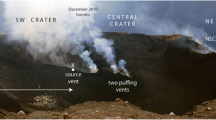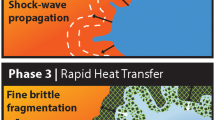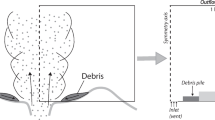Abstract
Eruptions of gas or steam and non-juvenile debris are common in volcanic and hydrothermal areas. From reports of non-juvenile eruptions or eruptive sequences world-wide, at least three types (or end-members) can be identified: (1) those involving rock and liquid water initially at boiling-point temperatures (‘boiling-point eruptions’); (2) those powered by gas (primarily water vapor) at initial temperatures approaching magmatic (‘gas eruptions’); and (3) those caused by rapid mixing of hot rock and ground- or surface water (‘mixing eruptions’). For these eruption types, the mechanical energy released, final temperatures, liquid water contents and maximum theoretical velocities are compared by assuming that the erupting mixtures of rock and fluid thermally equilibrate, then decompress isentropically from initial, near-surface pressure (≤10 MPa) to atmospheric pressure. Maximum mechanical energy release is by far greatest for gas eruptions (≤∼1.3 MJ/kg of fluid-rock mixture)-about one-half that of an equivalent mass of gunpowder and one-fourth that of TNT. It is somewhat less for mixing eruptions (≤∼0.4 MJ/kg), and least for boiling-point eruptions (≤∼0.25 MJ/kg). The final water contents of crupted boiling-point mixtures are usually high, producing wet, sloppy deposits. Final erupted mixtures from gas eruptions are nearly always dry, whereas those from mixing eruptions vary from wet to dry. If all the enthalpy released in the eruptions were converted to kinetic energy, the final velocity (v max) of these mixtures could range up to 670 m/s for boiling-point eruptions and 1820 m/s for gas eruptions (highest for high initial pressure and mass fractions of rock (m r) near zero). For mixing eruptions, v max ranges up to 1150 m/s. All observed eruption velocities are less than 400 m/s, largely because (1) most solid material is expelled when m r is high, hence v max is low; (2) observations are made of large blocks the velocities of which may be less than the average for the mixture; (3) heat from solid particles is not efficiently transferred to the fluid during the eruptions; and (4) maximum velocities are reduced by choked flow or friction in the conduit.
Similar content being viewed by others
References
Bacon CR (1983) Eruptive history of Mount Mazama and Crater Lake caldera, Cascade Range, U.S.A. J Volcanol Geotherm Res 18:57–115
Bercich BJ, McKibbin R (1992) Modelling the development of natural hydrothermal eruptions. Proc 14th NZ Geoth Workshop 1992, pp 305–312, and corrigendum, Proc 15th NZ Geoth Workshop 1993, University of Auckland, Auckland, New Zealand, pp 345–346
Bixley PF, Browne PRL (1988) Hydrothermal eruption potential in geothermal development. Proc 10th New Zealand Geothermal Workshop, University of Auckland, Auckland, New Zealand, pp 195–198
Browne PRL, Lloyd EF (1986) Water dominated geothermal systems and associated mineralisation. In: Taupo Volcanic Zone: Tour Guides C1, C4, C5, and A2, New Zealand Geol Survey Record 11:145–212
Buresti G, Casarosa C (1989) One-dimensional adiabatic flow of equilibrium gas-particle mixtures in long vertical ducts with friction. J Fluid Mech 203:251–272
Burnham CW (1979) Magmas and Hydrothermal Fluids. In: Barnes HL (ed) Geochemistry of Hydrothermal Ore Deposits. Wiley, New York, pp 71–136
Decker RW, Christiansen RL (1984) Explosive eruptions of Kilauea Volcano, Hawaii. In: Explosive Volcanism: Inception, Evolution, and Hazards. National Academy Press, Washington, pp 122–132
Dowden J, Kapadia P, Brown G, Rymer H (1991) Dynamics of a geyser eruption. J Geophys Res 96:18059–18071
Fagents SA, Wilson L (1993) Explosive volcanic eruptions; VII, The ranges of pyroclasts ejected in transient volcanic explosions. Geophys J Int 113:359–370
Finch RH (1943) Lava surgings in Halemaumau and the explosive eruptions in 1924. The Volcano Letter 479:1–4
Fink JH, Anderson SW, Manley CR (1992) Textural constraints on effusive silicic volcanism: beyond the permeable foam model. J Geophys Res 97:9073–9083
Fisher RV, Schmincke H-U (1984) Pyroclastic Rocks. Springer-Verlag, Berlin, pp 1–472
Francis P, Self S (1983) The eruption of Krakatau. Sci Am 249:172–187
Fudali RF, Melson WG (1972) Ejecta velocities, magma chamber pressure and kinetic energy associated with the 1968 eruption of Arenal Volcano. Bull Volcanol 35:383–401
Goguel J (1956) Le mécanisme des explosions phréatiques: Pub Bur Central Seismol Int Ser A, Trav Sci 19:165–175
Haar L, Gallagher JS, Kell GS (1984) NBS/NRC Steam Tables. Hemisphere, New York, pp 1–320
Hedenquist JW, Henley RW (1985) Hydrothermal eruptions in the Waiotapu geothermal system. Econ Geol 80:1640–1688
Hildreth W (1983) The compositionally zoned eruption of 1912 in the Valley of Ten Thousand Smokes, Katmai National Park, Alaska. J Volcanol Geotherm Res 18:1–56
Hoadley RB (1980) Understanding Wood. Taunton Press, Newtown, pp 1–256
Ingebritsen SE, Rojstaczer SA (1993) Controls on geyser periodicity. Science 262:889–891
Ishihara K (1985) Dynamical analysis of volcanic explosion. J Geodyn 3:327–349
Jaggar TA (1949) Steam blast volcanic eruptions. Hawaii Volc Obs, 4th Spec Rep
Kiefer G (1981) Les explosions phréatiques et phréatomagmatiques terminales a l'Etna. Bull Volcanol 44:655–660
Kieffer SW (1977) Sound speed in liquid-gas mixtures: water-air and water-steam. J Geophys Res 82:2895–2904
Kieffer SW (1984) Factors governing the structure of volcanic jets. In: Explosive Volcanism, Inception, Evolution, and Hazards. National Academy Press, Washington DC, pp 143–157
Kieffer SW, Delany JM (1979) Isentropic decompression of fluids from crustal and mantle pressures. J Geophys Res 84:1611–1620
Le Guern F, Bernard A, Chevrier RM (1980) Soufriere of Guadeloupe 1976–1977 eruption-mass and energy transfer and volcanic health hazards. Bull Volcanol 43:578–592
Liepmann HW, Roshko A (1957) Elements of Gasdynamics. Wiley, New York, pp 1–439
Lloyd EF, Keam RF (1974) Trinity Terrace hydrothermal eruption, Waimangu, New Zealand. N Z J Sci 17:511–528
Long PE (1989) Interaction of basalt flows with water during emplacement and solidification [abstract]. In: Proc 1989 IAVCEI Mtg, Santa Fe, NM, p 166
MacDonald GA (1972) Volcanoes. Prentice-Hall, Englewood Cliffs, pp 1–510
Marinelli G (1969) Some geological data on the geothermal areas of Tuscany. Bull Volcanol 33:319–333
Marini L, Principe C, Chiodini G, Cioni R, Fytikas M, Marinelli G (1993) Hydrothermal eruptions of Nisyros (Dodecanese, Greece). Past events and present hazard. J Volcanol Geotherm Res 56:71–94
Mastin LG (1991) The roles of magma and groundwater in the phreatic eruptions at Inyo Craters, Long Valley Caldera, California. Bull Volcanol 53:579–596
Mastin LG (1994) Explosive tephra emissions at Mount St. Helens, 1989–1991: the violent escape of magmatic gas following storms? Geol Soc Am Bull 106:175–185
McPhie J, Walker GP, Christiansen RL (1990) Phreatomagmatic and phreatic fall and surge deposits from explosions at Kilauea volcano, Hawaii, 1790 A.D.: Keanakakoi Ash Member. Bull Volcanol 52:334–354
Minakami T (1942) On the distribution of volcanic ejecta (Part I). The distributions of volcanic bombs ejected by the recent explosions of Asama. Bull Earthquake Res Inst, Tokyo 20:65–91
Moran MJ, Shapiro HN (1992) Fundamentals of Engineering Thermodynamics, 2nd edn. Wiley, New York, pp 1–804
Moyer TC, Swanson DA (1987) Secondary hydroeruptions in pyroclastic-flow deposits: examples from Mount St. Helens. J Volcanol Geotherm Res 32:299–319
Muffler LJP, White DE, Truesdell AH (1971) Hydrothermal explosion craters in Yellowstone National Park. Geol Soc Am Bull 82:723–740
Nairn IA (1979) Rotomahana-Waimangu eruption, 1886: base surge and basalt magma. N Z J Geol Geophys 22:363–378
Nairn IA, Self S (1978) Explosive eruptions and pyroclastic avalanches from Ngauruhoe in February 1975. J Volcanol Geotherm Res 3:39–60
Nairn IA, Wiradiradja S (1980) Late Quaternary hydrothermal explosion breccias at Kawerau Geothermal Field, New Zealand. Bull Volcanol 43:1–13
Nairn IA, Wood CP, Hewson CAY (1979) Phreatic eruptions of Ruapehu: April 1975. N Z J Geol Geophys 22:155–173
Nelson CE, Giles DL (1985) Hydrothermal eruption mechanisms and hot spring gold deposits. Econ Geol 80:1633–1639
Perret FA (1937) The eruption of Mt. Pelee, 1929–1932. In: Carnegie Inst Wash Publ 458, p 126
Rosi M (1992) A model for the formation of vesiculated tuff by the coalescence of accretionary lapilli. Bull Volcanol 54:429–434
Saad MA (1985) Compressible Fluid Flow. Prentice-Hall, Englewood Cliffs, pp 1–560
Self S, Wilson L, Nairn IA (1979) Vulcanian eruption mechanisms. Nature 277:440–443
Smithsonian Institution (1992) Galeras (Colombia) explosion kills 9 people on the active cone, including 6 volcanologists. Bull Global Volcanism Network 17(12):2–4
Smithsonian Institution (1993) Santiaguito (Guatemala) lava effusion and frequent explosions. Bull Global Volcanism Network 18(11):3–6
Sparks RSJ, Wilson L (1976) A model for the formation of ignimbrite by gravitational column collapse. J Geol Soc London 132:441–451
Stearns HA, MacDonald GA (1946) Geology and ground-water resources of the island of Hawaii. Hawaii Div Hydrogr Bull 9:1–363
Stevenson DS (1993) Physical models of fumarolic flow. J Volcanol Geotherm Res 57:139–156
Stix J, Zapata JA, Calvache M, Cortés GP, Fischer TP, Gómez D, Narvaez L, Ordoñez M, Ortega A, Torres R, Williams SN (1993) A model of degassing at Galeras Volcano, Colombia, 1988–1993. Geology 21:963–967
Telford WM, Geldart LP, Sheriff RE, Keys DA (1976) Applied Geophysics. Cambridge University Press, Cambridge, pp 1–860
White DE (1955) Violent mud-volcano eruptions of Lake City Hot Springs, northeastern California. Geol Soc Am Bull 66:1109–1130
White DE (1967) Some principles of geyser activity, mainly from Steamboat Springs, Nevada. Am J Sci 265:641–684
Wilson L (1972) Explosive volcanic eruptions — II. The atmospheric trajectories of pyroclasts. Geophys J R Astron Soc 30:381–392
Wilson L (1980) Relationships between pressure, volatile content and ejecta velocity in three types of volcanic explosion. J Volcanol Geotherm Res 8:297–313
Wohletz KH (1986) Explosive magma-water interactions: thermodynamics, explosion mechanisms, and field studies. Bull Volcanol 48:245–264
Wolfe EW, Hoblitt RP. Overview of the eruptions. In: Newhall CG, Punongbayan RS (eds) Eruptions and Lahars at Mount Pinatubo, Philipines. US Geol Surv Prof Pap in press
Zimanowski B, Fröhlich G, Lorenz V (1991) Quantitative experiments on phreatomagmatic explosions. J Volcanol Geotherm Res 48:341–348
Zlotnicki J, Boudon G, Le Mouel J-L (1992) The volcanic activity of La Soufriere of Guadeloupe (Lesser Antilles): structural and tectonic implications. J Volcanol Geotherm Res 49:91–104
Author information
Authors and Affiliations
Rights and permissions
About this article
Cite this article
Mastin, L.G. Thermodynamics of gas and steam-blast eruptions. Bull Volcanol 57, 85–98 (1995). https://doi.org/10.1007/BF00301399
Received:
Accepted:
Issue Date:
DOI: https://doi.org/10.1007/BF00301399




